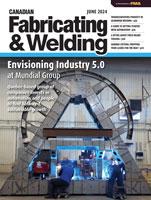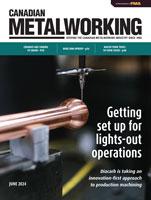Vice-President
- FMA
- The Fabricator
- FABTECH
- Canadian Metalworking
Leasing: Your questions get answered
It’s critical for shop owners to get their financing of new equipment right
- By Ken Hurwitz
- September 17, 2021
Editor’s Note: In this issue, Canadian Metalworking invited shop owners from across the country to submit leasing/financing questions to be answered by expert Ken Hurwitz. This is a selection of the most common themes and most interesting questions. To get your questions answered in a future issue, please send them to Editor Joe Thompson at: jthompson@canadianmetalworking.com.
Q: I’m into a good twin-spindle lathe for two more years, but I don’t have any work for it. What are my options?
A: The first thing to do is have your lender prepare a buyout for the machine (a combination of the remaining lease payments and the purchase option). Once this cost has been established, you have three options:
1. Buy out and resell the machine. It is very possible, particularly if the machine is a well-known brand and still in good working order, that the machine is worth at least as much as what is owed. Good brand-name machine tools tend to hold their value, and right now, one of the effects of COVID-19 is that delivery times for new machines are very long. Because we are in a busy market with limited availability, it is a very good time to sell a used machine.
2. Trade up to a new machine. Even if there is no work for your current machine, there could be a different machine or model sold by the company you bought it from that is better-suited to handle the work you have on your floor.
If this is the case, I would suggest approaching the seller to see what they will offer as a trade-in against a new machine. Once the net trade-in value is confirmed, then a trade-up can be arranged. This requires adding the net amount the machine seller requires for the new machine to the buyout amount of the old machine and arranging a new lease for the total.
Here is an example:
Let’s say that there are 36 payments remaining on the existing lease at $4,000 per month for a total of $144,000. If a new machine costs $250,000 and the trade-in value for the existing machine is $120,000, add the additional $130,000 the machine seller requires to the total of the lease payments owed on the existing machine and have the lender arrange a new lease for $274,000.
$250,000 (new machine cost)
- $120,000 (trade-in value)
-----------------------------------
$130,000
+$144,000 (leftover lease payments)
-------------------------------------
$274,000 (new lease value)
3. Find another shop to take over the lease. There may be another shop in your area that has work that is suited for your machine and requires additional capacity. All that is needed is for that shop to submit a credit review, and if approved, it can take possession of the equipment and start making the remaining payments.
Q: What’s the best way to turn older machines into a down payment?
A: There are a few ways to handle getting some money for an older machine tool.
No. 1 is to approach the seller of the new machine you want and see what, if anything, it will offer for the machine on trade against a new purchase. If the seller of the new machine is the same one that sold the original machine, it may be motivated to take in a used machine because it may know of a shop interested in one.
If the new equipment seller does not have any interest in the used machine, it most likely works with at least one reputable used equipment seller and can put you in contact with them.
The last option is to sell the equipment on your own. There are lots of ways to sell a machine privately. However, keep in mind that if this is the chosen route, it is important to ensure that payment is received in full, by cash, certified cheque, or bank draft, before releasing the equipment.
Q: What are the options for lease length, and how are they determined?
A: Typical equipment leases usually are two, three, four, or five years long. When I arrange a lease for a machine tool, the typical term is four or five years. The reason I use these terms is that it preserves a company’s cash flow.
Machine tools are very expensive assets, which is why leases are common in the first place. Minimizing payments makes sense for every manufacturer.
Most people assume that cash is tightest for shops when business is slow, but the reality is that a busy shop is under just as much financial pressure because of all the costs associated with being busy, including material, tooling, and labour.
Even once parts are delivered, it could be 60 to 90 days before the shop is paid. This is why keeping the monthly leasing payments as low as possible is a necessity.
A few funders in the marketplace will arrange a one-year lease, but the credit profile of the applicant has to be very strong. This may seem counterintuitive because a short term, like a year, has far less risk associated with it than a transaction that is four or five years long. However, lenders still need to make a profit too.
The amount of interest that can be charged in one year is far less than for five years, so the lender needs a source for very low cost of funds to make any profit. This typically can be done only with large institutions, typically the leasing arm of a bank or a large publicly traded leasing company, that have a low enough cost of funds for it to make sense to offer short-term money.
Q: I’m getting government funding for a project; can I use it for a machine lease, or do I have to buy a machine?
A: This can be a bit of a tricky one depending on how the grant is structured and whether there are stipulations on how the funds must be used.
Historically there has been a good amount of funding support for manufacturers from a variety of government programs. In many cases, these programs provide money with the intent that it be used as a deposit for equipment and the manufacturer can then pay in cash or arrange a lease for the difference.
I have arranged quite a few leases for my clients under these circumstances. However, there are other programs that require the provided money to be used for a specific piece of equipment, and the government funder will want to see both an invoice and bank statement confirming the recipient bought and paid for that equipment.
In these cases, using the money to make lease payments will not work because when a lease is arranged, the lender is the one who is invoiced and remits payment.
My suggestion is that if you are going to source some sort of government funding, retain a consultant who has experience in this area. I have worked with a few over the years, and they are very knowledgeable, particularly when it comes to identifying the best programs, putting together a successful application, and using the funds most efficiently.
Ken Hurwitz is vice-president, Equilease Corp., 416-499-2449, ken@equilease.com, www.equilease.com.
subscribe now


Keep up to date with the latest news, events, and technology for all things metal from our pair of monthly magazines written specifically for Canadian manufacturers!
Start Your Free SubscriptionAbout the Author

Ken Hurwitz
41 Scarsdale Road Unit 5
Toronto, M3B2R2 Canada
416-499-2449
- Trending Articles
New software, machine tool enables multiaxis production

Siemens' longtime CNC asset Randy Pearson dies

Rail helps increase workstation crane capacities

Hybrid method makes difficult-to-cut materials easy to cut

Disc style reamer features more blades for high-volume applications

- Industry Events
IMTS 2024
- September 9 - 14, 2024
- Chicago, IL
WiM Summit 2024
- October 6 - 9, 2024
- Boston, MA
FABTECH 2024 Orlando
- October 15 - 17, 2024
- Orlando, FL
















